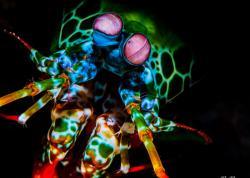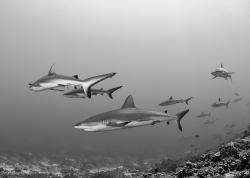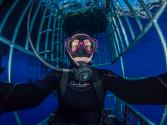One Shark Diver's Perspective: Caged vs Open Water Shark Diving
As most people are aware, there are a myriad of current and on-going debates about shark diving in general. Does diving with sharks alter their behavior? Does baiting sharks alter their behavior? Should divers be hand-feeding sharks? As you might expect, there are always two sides to every debate and, certainly, everyone is entitled to an opinion. Depending on which side of the fence (or cage) you find yourself, this article is not intended to change anyone’s opinion on shark diving in general. Rather, the purpose of this article is to illustrate one shark diver’s perspective on some of the thought processes and differences in preparation and execution that an underwater photographer might encounter diving with sharks either inside or outside a shark cage.
I live in South Florida, which means I have the opportunity to dive with sharks any time I want to. This diving is typically done in open water, without cages. I have had encounters with many shark species in these waters, and most of my shark diving experience has been without a cage. However, I have also gone cage diving, as that’s the only good way to get up close and personal with great white sharks in a safe and controlled environment. Fortunately, there happens to be a world-class great white shark location quite close to the US; Guadalupe, Mexico.

Inside the Cage
I have been on a few exclusively caged shark diving trips in Guadalupe, Mexico with the Nautilus fleet. When compared to open water shark diving, diving in a shark cage has its own unique set of thought processes and differences in preparation for the dives. First of all, diving in Guadalupe is based upon a hookah system, where divers breathe surface-supplied air. In the cages, divers wear a harness laden with lead, which is supplied by the boat and is crucial to keep them firmly planted on the cage floor. As such, divers are only required to bring their own mask, wetsuit, hood gloves and booties, so packing is much easier with regard to scuba gear.
Packing underwater camera gear, however, can present more of a challenge when preparing for a caged trip. How close will the sharks be? How clear will the water be? Should I use a fisheye or rectilinear lens? Do I bring my 4”, 6” or 8” dome port? How far apart are the bars of the cages? I found that divers tend to bring a lot of camera gear with them but wind up using one lens and dome port. My personal choice for the caged diving I did was a Panasonic 7-14/F 4.0 lens and a Zen 6” glass dome port – large enough to capture the action yet small enough to stay of other photographers' photos.

Being submerged in a cage brings its own challenges as well. Most cages hold around 3-4 divers. While that does not sound like a lot of people, think about 3-4 divers with their respective camera rigs, and everyone trying to move around to jockey for the best photo opportunities. It can get very crowded in the cages and it is best to remember to practice good underwater photographer niceties. The cage bars can also hold some pitfalls, in that you are having to compose your shots either through the bars or, if possible, between the bars. And visibility can sometimes become less-than-stellar, rendering photos nearly impossible.
On the flip side, however, there are some wonderful positives about cage diving with sharks. It is generally much safer diving within the confines of a shark cage rather than in open water. It is a much more closely controlled environment with respect to dive times and depth, and there is usually a dive guide or DM present. With cage diving, there is typically a dive schedule on which you can count, so you can be assured of getting the bottom time you want. You can also choose which depth of cage you want to enter, either surface or 30’-40’, which allows you to plan for more consistent images with respect to depth/water column color.

Join us for an opportunity to experience cage diving with Great White sharks!
Great White Sharks Photo Workshop in Guadalupe 2018
September 11-16, 2018
Price:
Triple Occupancy $2,935
Stateroom $3,250
Superior Suite $3,775
Premium Suite $4,405
Single Occupancy $4,062
Open Water Shark Diving
As I mentioned before, those of us living in South Florida have the opportunity to dive with sharks at any time, primarily in open water and without cages. On a moment’s notice anyone can jump onto a dive boat that heads out to the international waters of the Atlantic, where they can interact with a number of different shark species, depending on the time of year. Common encounters include hammerheads, tigers, lemons, bulls, nurse, reef, duskies, sandbars, silkies, and sometimes we get lucky and an occasional great white, whale shark or oceanic white tip swims by.
A typical day on one of these charters goes something like this: after all your initial preparation for the dive day, you arrive at the boat and get your scuba gear set up and find a spot for your camera rig. Initially there’s lots of controlled chaos where gear is strewn about, but eventually everything finds its own place. Once the dive gear is set, there is usually a very detailed boat briefing by the captain/mate as to the boat, safety, events of the day, etc. Then there is usually a dive briefing as to the dive site and the type of sharks we might expect to see. There is usually a list of “do’s and don’ts” that is reviewed each time with shark diving – no bright colors, no white tanks, no exposed skin, hoods/gloves mandatory, etc. In South Florida, trips to the dive site can be lengthy so there is ample time to tweak your camera and/or scuba gear on the ride out. This also provides time to plan your dive as well as anticipating the images you might like to capture.
My rig consists of an Olympus OM-D EM-1 MKII, Nauticam housing, Zen 6” glass dome port and dual Inon Z240s. When doing open water shark diving, I vacillate between my Panasonic 7-14mm and Panasonic 8mm fisheye. I sometimes look ahead at the NOAA forecast to see what weather conditions are going to be for that day, then decide if I want to chance using the 8mm. When using the 8mm lens, the sharks have to come in close to get decent images, but when they do come in close, the 8mm far outperforms the 7-14mm, in my opinion. Typically, though, I go with the 7-14mm to be safe.

Factors for Success
There are quite a lot of factors to consider when going on an open water shark dive without a cage. First of all, things like weather, current, visibility, seasickness, buoyancy control, the number/experience level of the divers, the number/experience level of underwater photographers, the number/experience level of underwater videographers, and number and species of sharks can all play a role as to whether or not you have a successful day with images.
For example, if you are on a dive with divers who do not have a lot of experience diving with sharks, it can be frustrating when you get set up for a gorgeous incoming tiger shark face portrait straight on, and a newer, less experienced diver shoves his/her GoPro in front of your dome port to catch the action (and of course the reverse is true as well.) Another not-so-fun scenario is this: the dive is on a wreck in the sand, and all divers are kneeling in the sand waiting for the sharks to arrive. However, there is a ripping current pushing all the divers everywhere thereby kicking up the sand making photos nearly impossible. Or the worst scenario of all: no sharks show up that day! Each of these factors plays a role in getting the images you want, and some of them are not entirely within your control.

…and more challenges...
However, while I think that diving with sharks in open water affords us more leeway and freedoms, it can also present more challenges. As mentioned earlier, having that tiger shark follow you through the water column to the surface, you have to be cognizant of the need to change camera settings in an instant as you turn 360 degree circles in the water following the movements of the shark(s). Now, for that sunburst shot you have been planning all dive long, the ISO, f/stop and shutter speeds are completely different than that taken for a shot in the blue. Additionally, not only do you need to change the camera settings, but the strobe settings and position as well.
Therefore, an open water shark diver has to be keen on the ever-changing environment of having one’s head on a proverbial swivel and being able to make the necessary changes in body position/buoyancy, camera settings, strobe settings/position and being mindful of the shark’s position. Another challenge with open water shark diving is that it is so exhilarating diving with sharks that sometimes it is difficult to remember to watch your bottom time and manage your no deco limits with all the nonstop action around you. There is one thing for sure that every shark diver can agree - it certainly is a dynamic process diving with sharks in open water, and one needs to be skillful at a multitude of tasks.

The Verdict
To summarize, I am definitely a shark diving advocate, both in open water and in a cage. There are pitfalls and positives for both, as most divers will attest, and one is not better than the other – they are just different. There are different underwater photo opportunities to be gleaned from diving in open water with sharks than in cages, but this also brings more inherent risks. Diving with sharks either inside or outside of a cage takes differing degrees of preparation, both topside and at depth.
Every diver knows that when we enter the underwater realm, we are in an environment in which we are a visitor. We take chances simply by breathing underwater and when diving with sharks, we compound that risk significantly. Sharks are one of the underwater apex predators and deserve our respect and admiration. They also deserve our help in presenting them in a much softer light in our underwater images and videos, which will help to dispel the evil media-driven myths about sharks.
(Editor's note: for a great camera for shooting action shots of great whites in the higest resolution available, check out the Sony A7RIV)
Upcoming Trips with Exciting Shark Photo Opportunities
Additional Reading
RECOMMENDED ARTICLES
SUPPORT THE UNDERWATER PHOTOGRAPHY GUIDE:
The Best Service & Prices on u/w Photo Gear
 Visit Bluewater Photo & Video for all your underwater photography and video gear. Click, or call the team at (310) 633-5052 for expert advice!
Visit Bluewater Photo & Video for all your underwater photography and video gear. Click, or call the team at (310) 633-5052 for expert advice!
The Best Pricing, Service & Expert Advice to Book your Dive Trips
 Bluewater Travel is your full-service scuba travel agency. Let our expert advisers plan and book your next dive vacation. Run by divers, for divers.
Bluewater Travel is your full-service scuba travel agency. Let our expert advisers plan and book your next dive vacation. Run by divers, for divers.
































